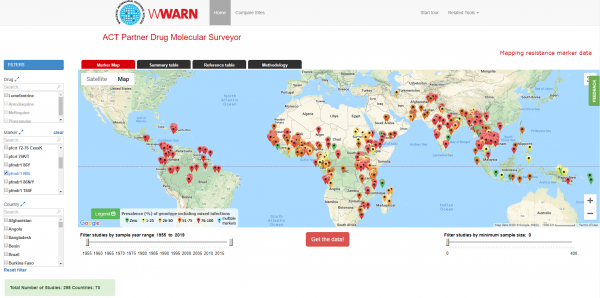Mapping malaria resistance using the ACT Partner Drug Molecular Surveyor
A recent article published in Malaria Journal by members of the WWARN Molecular Scientific and Informatics Group describes the development of WWARN’s ACT Partner Drug Molecular Surveyor. Launched in 2015, this online mapping tool supports the malaria community to track over nearly 20 years the prevalence of the molecular markers that are associated with antimalarial drug resistance.

The emergence and spread of drug resistance is threatening the global progress made towards malaria elimination. Many of WWARN's research partners have contributed towards the identification of the genetic changes in the Plasmodium falciparum malaria parasite that are commonly associated with the development of drug resistance. These include, specific changes in the genes pfcrt and pfmdr-1 observed during prolonged use of the widely used antimalarials amodiaquine, lumefantrine, mefloquine and chloroquine. The ACT Partner Drug Surveyor visualises the prevalence of these molecular markers, allowing users to observe trends over time on a local, national and global level.
Research studies are often designed and conducted differently making comparison and large-scale oversight challenging. Tracking resistance in a uniform, coordinated way across countries is vital to help monitor the emergence or spread of resistance and provide evidence to support the development of malaria treatment guidelines.
Former WWARN Lead Scientist, Georgina Humphreys says,"The ACT Partner Drug Surveyor presents existing published data from 2001–2017 and is continually updated with the latest study results. It includes more than 579 geographic sites in 76 different countries, including results from over 86,000 samples from 456 articles. You can view these data by molecular marker, sample size, country and the year the sample was collected."
Prof Sabina Otienoburu, one of the authors on the paper, adds "The Surveyor gives a unprecedented overview of the spread of molecular markers, enabling investigators to make informed decisions to guide their research objectives. In addition to the visualisations that we provide, you can download the data and run your own analysis."
Senior Scientific Advisor, Prof Carol Sibley, suggests, "Our efforts to harmonise data over many years emphasises the need for all studies to include a minimum set of common variables. If all studies did include the minimum set, it would enable even more data to be included in the ACT Partner Drug Surveyor, and would also greatly help to strengthen the accuracy of observations."
Ignacio Suay, co-author on the Malaria Journal paper concludes, "The WWARN Informatics team is continually building on the portfolio of surveyors, you can freely access the Artemisinin Surveyor and the P. vivax Surveyor. We also made the code available open-source, if you'd like to ask us any questions, email info@wwarn.org."
Read the paper: Humphreys et al. An online mapping database of molecular markers of drug resistance in Plasmodium falciparum: the ACT Partner Drug Molecular Surveyor. Malaria Journal. Published 18 January 2019.
Explore the ACT Partner Drug Molecular Surveyor

